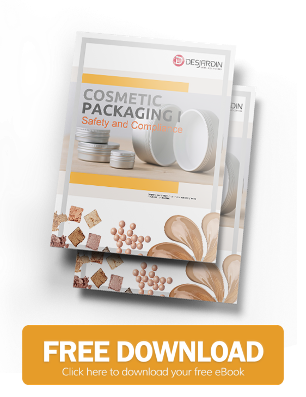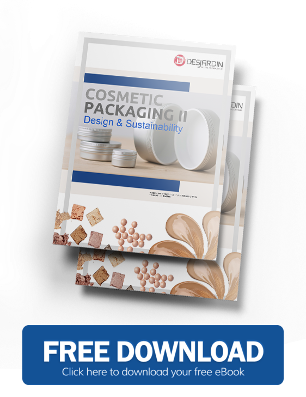Cosmetics are a broad category of health and beauty products. They range from things applied to the face like makeup to nail polish and even hair coloring and lotion. This very broad range of products contains a similarly broad range of materials used to make them. These materials all have different factors to consider when creating safe packaging. It can be a costly process to continually design new packaging for products, so many cosmetic companies rely on packaging specialists. These companies work hard to meet packaging demands of the ever growing cosmetic market. As of 2017 the global cosmetic market was valued at over $530 billion and are expected to grow to upwards of $800 billion by 2023. This means there will continue to be a growing demand for cosmetic packaging [1].
Packaging for cosmetics is very important for a variety of factors, but one of the main reasons is because they often contain a variety of ingredients. In the U.S. there are approximately 12,500 ingredients approved for the use in cosmetics. Typically cosmetics contain between 15 and 50 different ingredients each. Often these ingredients have different properties and can interact in unique ways to create different corrosive or challenging properties. The most common ingredients found in cosmetics include water, preservatives, moisturisers, colours, fragrances, emulsifiers, and thickeners. Many cosmetics also contain potentially dangerous chemicals, but they are used in small enough doses that they don’t pose any health risk to humans. For example triclosan is used in many cosmetics to protect against bacteria growth, but some studies have found that prolonged human exposure to it can cause cancer and under certain conditions it can breakdown into dioxins, which can be corrosive [2,3].
Cosmetic packaging also has to consider protecting against contamination. If packaging breaks down or the product isn’t sufficiently protected it can become contaminated by bacteria or dust. This can lead to major health problems for consumers. Lastly, the packaging itself must be free of harmful substances. It is possible for lead and other negative compounds to leach from packaging materials into the protect. This can cause products to become unusable and dangerous [6].
 The first area to consider in designing cosmetic packaging is the outer material that is used. The outer material must be strong enough to protect against physical contact like compression and tension. In addition it should act as a barrier against contaminants outside the container, like oxygen, dust, and bacteria. If the outer packaging fails the interior can become contaminated making the contents unusable and often unsafe. The secondary role of the outer container is to protect against thermal, biological, and chemical threats. If the material is unable to do so alone then additional coatings and seals can be used to augment this first line of defense. Some of the most common outer materials include aluminum and tinplate because of their good strength and rigidity while remaining relatively light. Additionally, they are two of the most environmentally friendly packaging materials as they are easy to recycle and reuse [4,5].
The first area to consider in designing cosmetic packaging is the outer material that is used. The outer material must be strong enough to protect against physical contact like compression and tension. In addition it should act as a barrier against contaminants outside the container, like oxygen, dust, and bacteria. If the outer packaging fails the interior can become contaminated making the contents unusable and often unsafe. The secondary role of the outer container is to protect against thermal, biological, and chemical threats. If the material is unable to do so alone then additional coatings and seals can be used to augment this first line of defense. Some of the most common outer materials include aluminum and tinplate because of their good strength and rigidity while remaining relatively light. Additionally, they are two of the most environmentally friendly packaging materials as they are easy to recycle and reuse [4,5].
The second aspect of cosmetic packaging taken into consideration is the seal. The seal acts as a physical barrier in areas where the exterior package is not present. This is often found around the lid of containers and when packaging is opened for the first time. Seals protect against all forms of contamination, such as bacteria, water, oxygen, dust, and chemical compounds. Seals are generally made with rubber, plastic, or other petroleum based products. These compounds should be able to withstand all corrosive ingredients in the cosmetics themselves, as well as all possible exterior threats, like heat and pressure. Additionally, the seals should be produced with non harmful compounds and be able to maintain a long shelf life with minimal risk of degrading [6]
 The outer material and seal work largely to protect against threats from outside of the container. The interior of cosmetic containers are often covered with types of varnishes and coatings to protect the metal of the package from the corrosive aspects of the product. These coatings are made with a wide variety of ingredients that vary based upon what properties the cosmetic product has. One of the most common types of coatings used are epoxy resins, which form a hard, thin layer on metal. They are free of pores, which provides less surface area for compounds to bind to, and do not sag over time. Generally, the coatings are designed to be either resistant to very alkaline or acidic conditions. After that they all have added resistance to standard aspects, like heat. They also prevent toxic compounds from migrating into the product from the container. Legislation requires that coatings are below the limit of 0.5 mg/in2 for the migration of non volatile compounds from the coating material into the product and are approved by the FDA or EU [7,8,9].
The outer material and seal work largely to protect against threats from outside of the container. The interior of cosmetic containers are often covered with types of varnishes and coatings to protect the metal of the package from the corrosive aspects of the product. These coatings are made with a wide variety of ingredients that vary based upon what properties the cosmetic product has. One of the most common types of coatings used are epoxy resins, which form a hard, thin layer on metal. They are free of pores, which provides less surface area for compounds to bind to, and do not sag over time. Generally, the coatings are designed to be either resistant to very alkaline or acidic conditions. After that they all have added resistance to standard aspects, like heat. They also prevent toxic compounds from migrating into the product from the container. Legislation requires that coatings are below the limit of 0.5 mg/in2 for the migration of non volatile compounds from the coating material into the product and are approved by the FDA or EU [7,8,9].
If precautions aren’t taken when deciding on packaging for cosmetics there can be real problems. In 2011 an eye shadow had to be recalled because it was found to contain the bacteria Pseudomonas Luteola, which can cause issues like cellulitis, bacteremia, and peritonitis. This was one example of a case that was caught before any consumers were harmed. In another case in 2000 a woman used a new eye cream, which had developed a growth of bacteria. When applied it caused her to feel a burning sensation and the skin around her eyes peeled for the next week [10].
Cosmetic packaging is developed and chosen in case specific situations. Biological, chemical, and physical factors should be considered in all cases before an informed decision can be made. Additionally, all packaging components must meet government requirements set forth by the EU and FDA. Packaging serves to protect consumers against harmful contamination in cosmetic products.
References
[1] "Cosmetic Products Market - Segmented by Product Type , and Region - Growth, Trends and Forecast " (2019), by Mordor Intelligence.
[2] "The Chemistry of Cosmetics" (retrieved April 2019), by Dr. Oliver Jones and Prof. Ben Selinger.
[3] "Compound - Tetradioxin" (retrieved April 2019), by National Center for Biotechnology Information.
[4] "Purposes of Cosmetic Packaging" (2016), by Alex Cosper.
[5] "What you should know when packaging cosmetics compliant to FDA regulations" (2016), by Alex Cosper.
[6] "Regulation (EC) No 1223/2009 of the European Parliament and of the council" (2009), by Official Journal of the European Union.
[7] "Global Legislation for Food Packaging Materials" (2010), Rinus Rijk and Dr. Rob Veraart.
[8] "Distinguish How Polymeric Coatings Are Regulated in the U.S. and Europe" (2011), by Keller and Heckman LLP.
[9] "Standard resistant" (retrieved April 2019), by Protaral.
[10] "Dangerous beauty: FDA discusses contaminated cosmetics" (2011), by Melissa Dahl.






